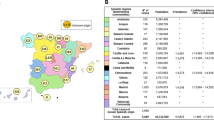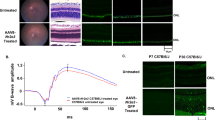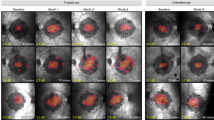Abstract
In light of the elucidation of the molecular pathogenesis of some dominantly inherited retinal degenerations over the past two decades, it is timely to explore possible means of therapeutic intervention for such diseases. However, the presence of significant levels of intergenic and intragenic genetic heterogeneity in this group of dominant conditions represents a barrier to the development of therapies focused on correcting the primary genetic defect. More than 60 genes have been implicated in dominant retinopathies and indeed over 150 different mutations in the rhodopsin gene alone have been identified in patients with autosomal dominant retinitis pigmentosa. Employing next-generation sequencing to characterise populations of retinal degeneration patients genetically over the coming years will beyond doubt serve to highlight further the immense genetic heterogeneity inherent in this group of disorders. Such diversity in genetic aetiologies has promoted the search for therapeutic solutions for dominantly inherited retinopathies that are independent of disease-causing mutations. The various approaches being considered to provide mutation-independent therapies for these dominant conditions will be discussed in the review, as will the preclinical data supporting the further development of such strategies.
This is a preview of subscription content, access via your institution
Access options
Subscribe to this journal
Receive 12 print issues and online access
$259.00 per year
only $21.58 per issue
Buy this article
- Purchase on Springer Link
- Instant access to full article PDF
Prices may be subject to local taxes which are calculated during checkout


Similar content being viewed by others
References
Bhattacharya SS, Wright AF, Clayton JF, Price WH, Phillips CI, McKeown CM et al. Close genetic linkage between X-linked retinitis pigmentosa and a restriction fragment length polymorphism identified by recombinant DNA probe L1.28. Nature 1984; 309: 253–255.
Bowne SJ, Sullivan LS, Koboldt DC, Ding L, Fulton R, Abbott RM et al. Identification of disease-causing mutations in autosomal dominant retinitis pigmentosa (adRP) using next-generation DNA sequencing. Invest Ophthalmol Vis Sci 2011; 52: 494–504.
Choi M, Scholl UI, Ji W, Liu T, Tikhonova IR, Zumbo P et al. Genetic diagnosis by whole exome capture and massively parallel DNA sequencing. Proc Natl Acad Sci USA 2009; 106: 19096–19101.
Ayuso C, Millan JM . Retinitis pigmentosa and allied conditions today: a paradigm of translational research. Genome Med 2010; 2: 34.
Farrar GJ, Kenna PF, Humphries P . On the genetics of retinitis pigmentosa and on mutation-independent approaches to therapeutic intervention. EMBO J 2002; 21: 857–864.
Mendes HF, van der Spuy J, Chapple JP, Cheetham ME . Mechanisms of cell death in rhodopsin retinitis pigmentosa: implications for therapy. Trends Mol Med 2005; 11: 177–185.
Millington-Ward S, O'Neill B, Tuohy G, Al-Jandal N, Kiang AS, Kenna PF et al. Strategems in vitro for gene therapies directed to dominant mutations. Hum Mol Genet 1997; 6: 1415–1426.
Hauswirth WW, Lewin AS . Ribozyme uses in retinal gene therapy. Prog Retin Eye Res 2000; 19: 689–710.
Kiang AS, Palfi A, Ader M, Kenna PF, Millington-Ward S, Clark G et al. Toward a gene therapy for dominant disease: validation of an RNA interference-based mutation-independent approach. Mol Ther 2005; 12: 555–561.
Gorbatyuk M, Justilien V, Liu J, Hauswirth WW, Lewin AS . Preservation of photoreceptor morphology and function in P23H rats using an allele independent ribozyme. Exp Eye Res 2007; 84: 44–52.
O′Reilly M, Palfi A, Chadderton N, Millington-Ward S, Ader M, Cronin T et al. RNA interference-mediated suppression and replacement of human rhodopsin in vivo. Am J Hum Genet 2007; 81: 127–135.
Chadderton N, Millington-Ward S, Palfi A, O'Reilly M, Tuohy G, Humphries MM et al. Improved retinal function in a mouse model of dominant retinitis pigmentosa following AAV-delivered gene therapy. Mol Ther 2009; 17: 593–599.
Millington-Ward S, Chadderton N, O′Reilly M, Palfi A, Goldmann T, Kilty C et al. Suppression and replacement gene therapy for autosomal dominant disease in a murine model of dominant retinitis pigmentosa. Mol Ther 2011; 19: 642–649.
Mussolino C, Sanges D, Marrocco E, Bonetti C, Di Vicino U, Marigo V et al. Zinc-finger-based transcriptional repression of rhodopsin in a model of dominant retinitis pigmentosa. EMBO Mol Med 2011; 3: 118–128.
Palfi A, Ader M, Kiang AS, Millington-Ward S, Clark G, O'Reilly M et al. RNAi-based suppression and replacement of RDS-peripherin in retinal organotypic culture. Hum Mutat 2006; 27: 260–268.
Georgiadis A, Tschernutter M, Bainbridge JWB, Robbie SJ, McIntosh J, Nathwani AC et al. AAV-mediated knockdown of peripherin-2 in vivo using miRNA-based hairpins. Gene Therapy 2010; 17: 486–493.
Takayama KM, Inouye M . Antisense RNA. Crit Rev Biochem Mol Biol 1990; 25: 155–184.
Bass BL, Cech TR . Specific interaction between the self-splicing RNA of Tetrahymena and its guanosine substrate: implications for biological catalysis by RNA. Nature 1984; 308: 820–826.
Fire A, Xu S, Montgomery MK, Kostas SA Driver SE, Mello CC . Potent and specific genetic interference by double-stranded RNA in Caenorhabditis elegans. Nature 1998; 391: 806–811.
Jaskiewicz L, Filipowicz W . Role of Dicer in posttranscriptional RNA silencing. Curr Top Microbiol Immunol 2008; 320: 77–97.
Dykxhoorn DM, Lieberman J . The silent revolution: RNA interference as basic biology, research tool, and therapeutic. Ann Rev Med 2005; 56: 401–423.
de Fougerolles A, Vornlocher HP, Maraganore J . Lieberman mechanism of RNA interference in mammalian cells. Nat Rev Drug Discov 2007; 6: 443–453.
Tan S, Guschin D, Davalos A, Lee YL, Snowden AW, Jouvenot Y . Zinc-finger protein-targeted gene regulation: genome-wide single-gene specificity. Proc Natl Acad Sci USA 2003; 100: 11997–12002.
Händel EM, Cathomen T . Zinc-finger nuclease based genome surgery: it's all about specificity. Curr Gene Ther 2011; 11: 28–37.
Akiyama H, Kachi S, Silva RL, Umeda N, Hackett SF, McCauley D . Intraocular injection of an aptamer that binds PDGF-B: a potential treatment for proliferative retinopathies. J Cell Physiol 2006; 207: 407–412.
Lv F, Qiu Y, Zhang Y, Liu S, Shi J, Liu Y et al. Adeno-associated virus-mediated anti-DR5 chimeric antibody expression suppresses human tumor growth in nude mice. Cancer Lett 2011; 302: 119–127.
Davis D, Stokoe D . Zinc finger nucleases as tools to understand and treat human diseases. BMC Med 2010; 8: 42.
Vandenberghe LH, Wilson JM, Gao G . Tailoring the AAV vector capsid for gene therapy. Gene Therapy 2009; 16: 311–319.
Surace EM, Auricchio A . Versatility of AAV vectors for retinal gene transfer. Vision Res 2008; 48: 353–359.
Weber M, Rabinowitz J, Provost N, Conrath H, Folliot S, Briot D . Recombinant adeno-associated virus serotype 4 mediates unique and exclusive long-term transduction of retinal pigmented epithelium in rat, dog, and nonhuman primate after subretinal delivery. Mol Ther 2003; 7: 774–781.
Foust KD, Nurre E, Montgomery CL, Hernandez A, Chan CM, Kaspar BK . Intravascular AAV9 preferentially targets neonatal neurons and adult astrocytes. Nat Biotechnol 2009; 27: 59–65.
Allocca M, Musolino C, Garcia-Hoyos M, Sanges D, Iodice C, Petrillo M et al. Novel adeno-associated virus serotypes efficiently transducer murine photoreceptors. J Virol 2007; 81: 11372–11380.
Bainbridge JW, Smith AJ, Barker SS, Robbie S, Henderson R, Balaggan K et al. Effect of gene therapy on visual function in Leber's congenital amaurosis. N Engl J Med 2008; 358: 2231–2239.
Maguire AM, Simonelli F, Pierce EA, Pugh Jr EN, Mingozzi F, Bennicelli J et al. Safety and efficacy of gene transfer for Leber's congenital amaurosis. N Engl J Med 2008; 358: 2240–2248.
Cideciyan AV, Aleman TS, Boye SL, Schwartz SB, Kaushal S, Roman AJ et al. Human gene therapy for RPE65 isomerase deficiency activates the retinoid cycle of vision but with slow rod kinetics. Proc Natl Acad Sci USA 2008; 105: 15112–15117.
Maguire AM, High KA, Auricchio A, Wright JF, Pierce EA, Testa F et al. Age-dependent effects of RPE65 gene therapy for Leber's congenital amaurosis: a phase 1 dose-escalation trial. Lancet 2009; 374: 1597–1605.
Simonelli F, Maguire AM, Testa F, Pierce EA, Mingozzi F, Bennicelli JL et al. Gene therapy for Leber′s congenital amaurosis is safe and effective through 1.5 years after vector administration. Mol Ther 2010; 18: 643–650.
Ghosh A, Yue Y, Duan D . Efficient transgene reconstitution with hybrid dual AAV vectors carrying the minimized bridging sequences. Hum Gene Ther 2011; 22: 77–83.
Li T, Snyder WK, Olsson JE, Dryja TP . Transgenic mice carrying the dominant rhodopsin mutation P347S: evidence for defective vectorial transport of rhodopsin to the outer segments. Proc Natl Acad Sci USA 1996; 93: 14176–14181.
Humphries MM, Rancourt D, Farrar GJ, Kenna P, Hazel M, Bush RA et al. Retinopathy induced in mice by targeted disruption of the rhodopsin gene. Nat Genet 1997; 15: 216–219.
Palfi A, Millington-Ward S, Chadderton N, O'Reilly M, Goldmann T, Humphries MM et al. Adeno-associated virus-mediated rhodopsin replacement provides therapeutic benefit in mice with a targeted disruption of the rhodopsin gene. Hum Gene Ther 2010; 21: 311–323.
Hu J, Matsui M, Gagnon KT, Schwartz JC, Gabillet S, Arar K et al. Allele-specific silencing of mutant huntingtin and ataxin-3 genes by targeting expanded CAG repeats in mRNAs. Nat Biotechnol 2009; 27: 478–484.
Brummelkamp TR, Bernards R, Agami R . Stable suppression of tumorigenicity by virus-mediated RNA interference. Cancer Cell 2002; 2: 243–247.
Feng X, Zhao P, He Y, Zuo Z . Allele-specific silencing of Alzheimer's disease genes: the amyloid precursor protein genes witht Swedish or London mutations. Gene 2006; 12: 68–74.
Lewin AS, Drenser KA, Hauswirth WW, Nishikawa S, Yasumura D, Flannery JG et al. Ribozyme rescue of photoreceptor cells in a transgenic rat model of autosomal dominant retinitis pigmentosa. Nat Med 1998; 4: 967–971.
Tessitore A, Parisi F, Denti MA, Allocca M, Di Vicino U, Domenici L et al. Preferential silencing of a common dominant rhodopsin mutation does not inhibit retinal degeneration in a transgenic model. Mol Ther 2006; 14: 692–699.
Shimayama T, Nishikawa S, Taira K . Generality of the NUX rule: kinetic analysis of the results of systematic mutation in the trinucleotide at the cleavage site of hammerhead ribozymes. Biochemistry 1995; 34: 3649–3654.
Mendes HF, van der Spuy J, Chapple JP . Cheetham ME Mechanisms of cell ceath in rhodopsin retinits pigmentosa: implication for therapy. Trends Mol Med 2005; 11: 177–185.
Mao H, Thomas Jr J, Schwein A, Shabashvili A, Hauswirth WW, Gorbatyuk MS et al. AAV delivery of wild-type rhodopsin preserves retinal function in a mouse model of autosomal dominant retinitis pigmentosa. Hum Gene Ther 2010; 22: 567–575.
Gu JJ, Tolin AK, Jain J, Huang H, Santiago L, Mitchell BS . Targeted disruption of the inosine 5′-monophosphate dehydrogenase type I gene in mice. Mol Cell Biol 2003; 23: 6702–6712.
Tam LC, Kiang AS, Kennan A, Kenna PF, Chadderton N, Ader M et al. Therapeutic benefit derived from RNAi-mediated ablation of IMPDH1 transcripts in a murine model of autosomal dominant retinitis pigmentosa (RP10). Hum Mol Genet 2008; 17: 2084–2100.
Lanni C, Stanga S, Racchi M, Govoni S . The expanding universe of neurotrophic factors: therapeutic potential in aging and age-associated disorders. Curr Pharm Des 2010; 16: 698–717.
Yang Y, Mohand-Said S, Danan A, Simonutti M, Fontaine V, Clerin E et al. Functional cone rescue by RdCVF protein in a dominant model of retinitis pigmentosa. Mol Ther 2009; 17: 787–795.
Haruta M, Bush RA, Kjellstrom S, Vijayasarathy C, Zeng Y, Le YZ et al. Depleting Rac1 in mouse rod photoreceptors protects them from photo-oxidative stress without affecting their structure or function. Proc Natl Acad Sci USA 2009; 106: 9397–9402.
Samardzija M, Wenzel A, Thiersch M, Frigg R, Remé C, Grimm C . Caspase-1 ablation protects photoreceptors in a model of autosomal dominant retinitis pigmentosa. Invest Ophthalmol Vis Sci 2006; 47: 5181–5190.
Nagai Y, Fujikake N, Popiel HA, Wada K . Induction of molecular chaperones as a therapeutic strategy for the polyglutamine diseases. Curr Pharm Biotechnol 2010; 11: 188–197.
Li Y, Tao W, Luo L, Huang D, Kauper K, Stabila P et al. CNTF induces regeneration of cone outer segments in a rat model of retinal degeneration. PLoS One 2010; 5: e9495.
McGee Sanftner LH, Abel H, Hauswirth WW, Flannery JG . Glial cell line derived neurotrophic factor delays photoreceptor degeneration in a transgenic rat model of retinitis pigmentosa. Mol Ther 2001; 4: 622–629.
Green ES, Rendahl KG, Zhou S, Ladner M, Coyne M, Srivastava R et al. Two animal models of retinal degeneration are rescued by recombinant adeno-associated virus-mediated production of FGF-5 and FGF-18. Mol Ther 2001; 3: 507–515.
Gregory-Evans K, Chang F, Hodges MD, Gregory-Evans CY . Ex vivo gene therapy using intravitreal injection of GDNF-secreting mouse embryonic stem cells in a rat model of retinal degeneration. Mol Vis 2009; 15: 962–973.
Buch RA, Lei B, Tao W, Raz D, Chan CC, Cox TA et al. Encapsulated cell-based intraocular delivery of ciliary neurotrophic factor in mormal rabbit: dose-dependent effects on ERG and retinal histology. Invest Ophthalmol Vis Sci 2004; 45: 2420–2430.
LaVail MM, Yasumura D, Matthes MT, Lau-Villacorta C, Unoki K, Sung CH et al. Protection of mouse photoreceptors by survival factors in retinal degenerations. Invest Ophthalmol Vis Sci 1998; 39: 592–602.
Chong NH, Alexander RA, Waters L, Barnett KC, Bird AC, Luthert PJ . Repeated injections of a ciliary neurotrophic factor analogue leading to long-term photoreceptor survival in hereditary retinal degeneration. Invest Ophthalmol Vis Sci 1999; 40: 1298–1305.
Rhee KD, Ruiz A, Duncan JL, Hauswirth WW, Lavail MM, Bok D et al. Molecular and cellular alterations induced by sustained expression of ciliary neurotrophic factor in a mouse model of retinitis pigmentosa. Invest Ophthalmol Vis Sci 2007; 48: 1389–1400.
Buch PK, MacLaren RE, Durán Y, Balaggan KS, MacNeil A, Schlichtenbrede FC et al. In contrast to AAV-mediated Cntf expression, AAV-mediated Gdnf expression enhances gene replacement therapy in rodent models of retinal degeneration. Mol Ther 2006; 14: 700–709.
Komeima K, Rogers BS, Campochiaro PA . Antioxidants slow photoreceptor cell death in mouse models of retinitis pigmentosa. J Cell Physiol 2007; 213: 809–815.
Lu L, Oveson BC, Jo YJ, Lauer TW, Usui S, Komeima K et al. Increased expression of glutathione peroxidase 4 strongly protects retina from oxidative damage. Antioxid Redox Signal 2009; 11: 715–724.
Usui S, Oveson BC, Lee SY, Jo YJ, Yoshida T, Miki A et al. NADPH oxidase plays a central role in cone cell death in retinitis pigmentosa. J Neurochem 2009; 110: 1028–1037.
Levéillard T, Mohand-Said S, Lorentz O, Hicks D, Fintz A, Clérin E et al. Identification and characterization of rod-derived cone viability factor. Nat Genet 2004; 36: 755–759.
Yang Y, Mohand-Said S, Danan A, Simonutti M, Fontaine V, Clérin E et al. Functional cone rescue by RdCVF protein in a dominant model of retinitis pigmentosa. Mol Ther 2009; 17: 787–795.
Fridlich R, Delalande F, Jaillard C, Lu J, Poidevin L, Cronin T et al. The thioredoxin-like protein rod-derived cone viability factor (RdCVFL) interacts with TAU and inhibits its phosphorylation in the retina. Mol Cell Proteomics 2009; 8: 1206–1218.
Kong L, Zhou X, Li F, Yodoi J, McGinnis J, Cao W . Neuroprotective effect of overexpression of thioredoxin on photoreceptor degeneration in Tubby mice. Neurobiol Dis 2010; 38: 446–455.
Lin JH, Lavail MM . Misfolded proteins and retinal dystrophies. Adv Exp Med Biol 2010; 664: 115–121.
Arawaka S, Machiya Y, Kato T . Heat shock proteins as suppressors of accumulation of toxic prefibrillar intermediates and misfolded protein in neurodegenerative diseases. Curr Pharm Biotechnol 2010; 11: 158–166.
Sajjad MU, Samson B, Wyttenback A . Heat shock proteins: therapeutic drug targets for chronic neurodegeneration? Curr Pharm Biotechnol 2010; 11: 198–215.
Gorbatyuk MS, Knox T, LaVail MM Gorbatyuk OS, Noorwez SM, Hauswirth WW et al. Restoration of visual function in P23H rhodopsin transgenic rats by gene delivery of BiP/Grp78. Proc Natl Acad Sci USA 2010; 107: 5961–5966.
Tam LC, Kiang AS, Campbell M, Keaney J, Farrar GJ, Humphries MM et al. Prevention of autosomal dominant retinitis pigmentosa by systemic drug therapy targeting heat shock protein 90 (Hsp90). Hum Mol Genet 2010; 19: 4421–4436.
Author information
Authors and Affiliations
Corresponding author
Ethics declarations
Competing interests
The authors declare no conflict of interest.
Rights and permissions
About this article
Cite this article
Farrar, G., Millington-Ward, S., Chadderton, N. et al. Gene-based therapies for dominantly inherited retinopathies. Gene Ther 19, 137–144 (2012). https://doi.org/10.1038/gt.2011.172
Received:
Accepted:
Published:
Issue Date:
DOI: https://doi.org/10.1038/gt.2011.172
Keywords
This article is cited by
-
Gene augmentation for autosomal dominant retinitis pigmentosa using rhodopsin genomic loci nanoparticles in the P23H+/− knock-in murine model
Gene Therapy (2023)
-
Curative gene therapies for rare diseases
Journal of Community Genetics (2021)
-
Progress in gene therapy for neurological disorders
Nature Reviews Neurology (2013)
-
Ocular gene therapy: introduction to the special issue
Gene Therapy (2012)



